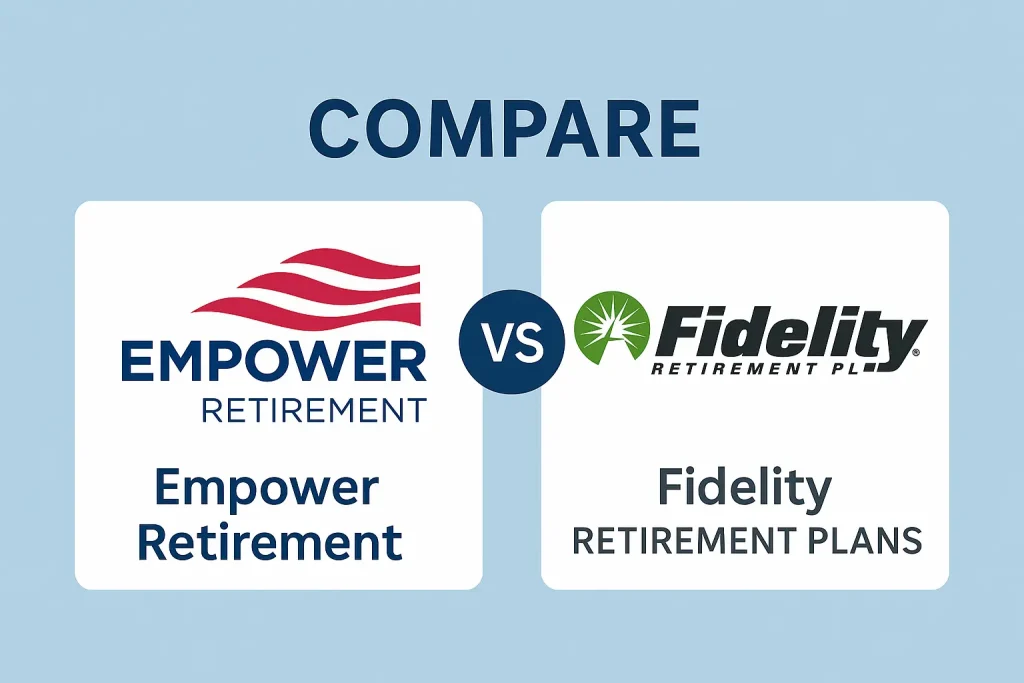Choosing the right platform for long-term financial goals requires understanding key differences between leading providers. This analysis explores two prominent options in wealth management, focusing on their approaches to helping investors grow savings effectively.
One service specializes in individual retirement accounts (IRAs) and managed portfolios tailored for future planning. Its structured advisory model suits those prioritizing dedicated retirement strategies. The competitor stands out with low-cost investment products and a full financial ecosystem, appealing to users wanting flexibility across trading, education, and portfolio management.
Fee transparency plays a critical role in decision-making. While one platform uses tiered pricing based on assets, the other emphasizes commission-free trades and straightforward expense ratios. Minimum investment thresholds also vary significantly, affecting accessibility for new investors versus high-net-worth individuals.
This comparison breaks down essential factors like account options, advisory support quality, and tools for different experience levels. Whether you prefer automated solutions or hands-on portfolio control, understanding these distinctions helps align choices with personal finance objectives.
Key Takeaways
- Specialized retirement accounts contrast with comprehensive wealth management platforms
- Tiered advisory fees differ from flat-rate pricing structures
- Minimum investment requirements vary by service tier
- Automated tools complement personalized financial guidance
- Platform selection depends on investor experience and goals
Understanding the Basics of Empower Retirement and Fidelity
Building a secure financial future begins with choosing partners whose values match your goals. Two industry leaders approach wealth growth differently, each with distinct histories and service models.
Company Histories and Backgrounds
One firm reshaped its strategy through strategic acquisitions. The 2020 purchase of Personal Capital allowed it to combine tech-driven insights with traditional advisory services. This move positioned the company as a hybrid solution for savers with over $100,000 in assets.
Meanwhile, its competitor boasts nearly eight decades of market experience. Starting as a mutual fund pioneer, it now serves 40 million clients through diverse financial products. This longevity creates trust among investors at all wealth levels.
Core Services and Offerings Overview
The first provider focuses on customized strategies for later-life planning. Its tools help clients visualize savings gaps and adjust contributions accordingly. Dedicated advisors create tailored portfolios blending stocks, bonds, and alternative assets.
In contrast, the second organization operates as a full-service hub. From starter brokerage accounts to complex estate planning, it supports every financial milestone. Self-directed traders appreciate its low-cost index funds, while beginners benefit from automated portfolio builders.
Both platforms prioritize long-term growth but cater to different needs. One excels in targeted wealth management, while the other offers breadth across investment types and experience levels.
empower retirement vs fidelity: Key Features and Offerings
Financial platforms differ in how they structure core products. Let’s examine account varieties and professional guidance models that shape long-term wealth-building strategies.
Retirement Account Options
Premier IRA eliminates administrative fees for traditional and Roth variations. Investors enjoy tax-advantaged growth without worrying about hidden charges. The brokerage version offers 20,000+ securities for hands-on traders, waiving annual costs for balances exceeding $100k.
Competitors provide three IRA types with distinct tax treatments. Their automated advisor requires no minimum deposit and charges zero fees until assets reach $10,000. This appeals to younger savers building nest eggs gradually.
| Feature | Empower | Fidelity |
|---|---|---|
| IRA Types | 2 | 3 |
| Fee-Free Threshold | $0 | $10k |
| Tradable Assets | 20,000+ | 10,000+ |
Wealth Management and Advisory Services
Managed portfolios start at $5,000 with fees decreasing as assets grow. High-net-worth clients access custom portfolios blending stocks, bonds, and alternative assets. This tiered approach rewards long-term commitment.
Alternative platforms offer four service tiers. Entry-level robo-advisory suits beginners, while premium tiers provide estate planning for multimillion-dollar portfolios. Personalized advice requires $25,000 – five times higher than some competitors.
| Service | Minimum | Fee Range |
|---|---|---|
| Empower Managed | $5k | 0.50%-0.85% |
| Fidelity Go | $0 | 0.35% |
| Private Wealth | $2M | Custom |
Choosing between specialized retirement tools and diversified financial ecosystems depends on whether you prioritize targeted savings or holistic wealth-building.
Detailed Comparison of Retirement Products and Fee Structures
Cost structures directly impact long-term returns, making fee analysis essential for informed decisions. Both platforms employ distinct pricing models that cater to different investor priorities and asset levels.
Fee Structures and Account Costs Explained
Tiered management fees create cost advantages for larger balances. One service reduces charges from 0.89% to 0.2% as portfolios surpass $400k. This approach benefits high-net-worth individuals building their next million through compounding growth.
Competitors prioritize accessibility with:
- Zero trading fees for stocks and ETFs
- Free robo-advisory under $10k
- Flat $3/month charges for mid-sized accounts
Active traders face critical differences. One platform allows 1,000 free transactions annually before applying $6.95 per trade. The other eliminates commission costs, appealing to frequent portfolio adjusters.
| Fee Type | Small Accounts | Large Accounts |
|---|---|---|
| Management | 0.89% | 0.2% |
| Trades | $6.95/post-free | Commission-free |
| Additional | $10-$20 penalties | Waived fees |
These structures reveal clear trade-offs. Cost-conscious investors and active traders often prefer one model, while wealth-building strategies favoring professional guidance align with the other.
Investment Options and Technology Platforms
Modern investors need platforms that combine diverse assets with intuitive technology. Access to varied financial products and smart tools shapes how users build and manage their portfolios effectively.

Trading Platforms and Mobile App Functionality
One service eliminates trading fees for stocks and ETFs, appealing to cost-conscious users. Its mobile interface prioritizes retirement tracking through personalized dashboards and contribution calculators. Investors can access 15,000+ mutual funds alongside bonds and equities.
Competitors provide broader asset classes, including commodities and global markets. Their app features advanced charting for active traders, plus real-time alerts for market shifts. Both platforms support iOS and Android, but cater to different priorities:
| Feature | Platform A | Platform B |
|---|---|---|
| Investment Types | ETFs, Stocks, Mutual Funds | Metals, CDs, International |
| Mobile Focus | Goal Tracking | Live Trading |
| Commission Fees | $0 | Select $0 options |
Research Tools and Educational Resources
Comprehensive analysis tools help users make informed decisions. One system offers interactive stock screeners and sector performance reports. Strategy builders let investors test approaches using historical data.
Educational materials differ significantly between services. While one emphasizes market trends and trading techniques, the other provides retirement-specific guides. Key resource comparisons show distinct advantages:
| Tool Type | Service X | Service Y |
|---|---|---|
| Research Depth | Expert Strategy Ideas | Retirement Calculators |
| Education Focus | Market Fundamentals | Savings Optimization |
| Accessibility | All Account Levels | Premium Features |
Performance and Customer Support Analysis
Evaluating financial platforms goes beyond numbers—responsive support shapes long-term success. How companies handle questions and technical issues often determines client retention. This section examines assistance quality and user satisfaction metrics across both services.
Customer Service Quality and Accessibility
One provider organizes customer service teams by expertise. Specialists handle workplace benefit plans separately from personal investment accounts. This structure ensures callers connect with advisors familiar with specific money management challenges.
Competitors take a different approach. Their unified support network offers live chat, email, and phone assistance through a single access point. Over 180 physical branches provide face-to-face guidance—a rare advantage in digital-first finance.
User Experience and Satisfaction Metrics
Recent surveys reveal that both platforms excel in resolution speed. Over 83% of users report issues addressed within 24 hours. However, satisfaction diverges in specialized advisory services. Those with complex retirement questions favor one provider’s targeted expertise.
Mobile app ratings highlight another contrast. While both score above 4.5 stars, users praise different features. One platform’s intuitive account aggregation tools simplify tracking multiple investments, while the other wins points for educational content explaining market trends.
Choosing between these models depends on priorities. Investors valuing specialized guidance may prefer segmented service channels. Those needing diverse contact options might prioritize accessibility over niche expertise.
Who Should Choose Empower Retirement vs Fidelity?
Matching financial platforms to personal objectives requires evaluating service strengths against individual priorities. Savers often face a crossroads between specialized guidance and versatile wealth-building tools.
Tailored Solutions for Different Goals
Managed Portfolio seekers with $5,000+ find one provider’s low entry point advantageous. This contrasts sharply with competitors requiring $25,000 for similar advisory access. Larger account holders ($100,000+) often benefit from customized strategies aligning with long-term savings targets.
Budget-focused investors prioritize platforms offering commission-free trades and educational materials. Those building diverse portfolios across multiple asset classes typically prefer extensive investment menus and real-time trading features.
Service selection ultimately depends on three factors: available capital, desired support level, and growth timeline. Regular portfolio reviews help determine if current providers still match evolving financial needs.
Fidelity Retirement Plans FAQ
What are the main differences between Empower Retirement and Fidelity?
Empower Retirement focuses on employer-sponsored plans like 401(k)s, while Fidelity offers a broader range of personal and workplace accounts, including IRAs, brokerage services, and wealth management. Fidelity provides more self-directed tools, whereas Empower emphasizes institutional retirement solutions.
How do fees compare between these platforms?
Fidelity often has lower expense ratios for funds and no account fees for basic services. Empower’s costs vary based on employer plans but may include administrative charges. Both offer transparent pricing, but fee structures depend on account types and advisory services used.
Which platform offers better investment options for beginners?
Fidelity’s user-friendly tools, educational resources, and robo-advisor services suit new investors. Empower caters more to workplace plans with limited customization, making Fidelity a stronger choice for hands-on learning and diversified portfolios.
Can I access financial advisors through both services?
Yes. Fidelity provides personalized advisory services for all account types, including hybrid human-digital support. Empower offers advisor access primarily through employer-sponsored plans, with fewer standalone wealth management options.
Which provider has stronger mobile app functionality?
Fidelity’s app is highly rated for trading, research, and account management. Empower’s mobile experience focuses on retirement plan tracking, with fewer features for active investors. Fidelity excels in real-time data and integrated tools.
Is one platform better for advanced traders?
Fidelity supports advanced trading strategies with its Active Trader Pro platform, offering ETFs, stocks, and options. Empower’s investment options are tailored to retirement accounts, with limited trading flexibility compared to Fidelity’s comprehensive brokerage services.

